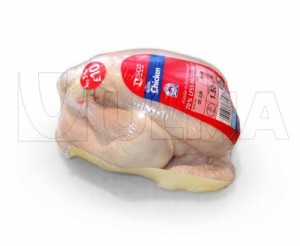The U.S. government is pushing the poultry industry to make their chicken and turkey a little safer with new standards aimed at reducing the number of cases of foodborne illness by 50,000 a year.
 The proposed standards announced Wednesday by the Agriculture Department apply to the most popular poultry products — chicken breasts, legs and wings, and ground chicken and turkey. They are voluntary but designed to pressure companies to lower rates of salmonella and campylobacter, another pathogen that can cause symptoms similar to salmonella, in their products.
The proposed standards announced Wednesday by the Agriculture Department apply to the most popular poultry products — chicken breasts, legs and wings, and ground chicken and turkey. They are voluntary but designed to pressure companies to lower rates of salmonella and campylobacter, another pathogen that can cause symptoms similar to salmonella, in their products.
Among the measures companies could take to reduce the rates of those pathogens: better screening of flocks and better sanitation.
The proposal would ask poultry producers to reduce the rates of salmonella in raw chicken parts from around 24 percent now to less than 16 percent, and campylobacter rates in raw chicken parts from 22 percent to 8 percent. Rates also would be reduced in ground chicken and turkey, and sampling would be done over a longer period of time to ensure accuracy.
The Agriculture Department says the standards could eventually reduce salmonella and campylobacter illnesses linked to raw poultry by about a quarter, or 50,000 illnesses a year.
“We are taking specific aim at making the poultry items that Americans most often purchase safer to eat,” said Agriculture Secretary Tom Vilsack.
Ashley Peterson of the National Chicken Council said the industry has already made improvements. She said poultry companies have been exploring options to reduce contamination, including
The standards come after a lengthy outbreak of salmonella illnesses linked to California chicken company Foster Farms, which sickened more than 600 people between March 2013 and July 2014. In 2013, USDA said inspectors at Foster Farms facilities had documented “fecal material on carcasses” along with poor sanitation.
Foster Farms took measures to improve its sanitation and screening, and the Centers for Disease Control and Prevention now says the company’s products have less than 5 percent salmonella.
 Vilsack said the Foster Farms outbreaks led the department to realize it needed to be more focused on reducing salmonella in chicken parts. The department already had standards in place for whole carcasses, but not individual parts like breasts and wings. The new proposal would cover the parts, which the USDA says is about 80 percent of chicken available for purchase.
Vilsack said the Foster Farms outbreaks led the department to realize it needed to be more focused on reducing salmonella in chicken parts. The department already had standards in place for whole carcasses, but not individual parts like breasts and wings. The new proposal would cover the parts, which the USDA says is about 80 percent of chicken available for purchase.
USDA also would make public which companies are meeting the standards or going beyond them, and which companies have more work to do, giving companies more incentive to comply.
The secretary said companies should realize that complying is good business. “It’s in the long-term best interest of the market to have safer food,” Vilsack said.
“These new standards, as well as improved testing patterns, will have a major impact on public health,” said USDA Deputy Under Secretary for Food Safety Al Almanza. “The proposed changes are another way we’re working to meet the ever-changing food safety landscape and better protect Americans from foodborne illness.”
“Getting more germs out of the chicken and turkey we eat is an important step in protecting people from foodborne illness,” said Robert V. Tauxe, MD, deputy director of the Division of Foodborne, Waterborne and Environmental Diseases at the Centers for Disease Control and Prevention. “I look forward to seeing fewer Americans get sick as a result of these proposed changes.”
A pathogen reduction performance standard is the measure that FSIS uses to assess the food safety performance of facilities that prepare meat and poultry products. By making the standards for ground poultry tougher to meet, ground poultry products nationwide will have less contamination and therefore result in fewer foodborne illnesses. FSIS implemented performance standards for whole chickens in 1996 but has since learned that Salmonella levels increase as chicken is further processed into parts. Poultry parts like breasts, wings and others represent 80 percent of the chicken available for Americans to purchase. By creating a standard for chicken parts, and by performing regulatory testing at a point closer to the final product, FSIS can greatly reduce consumer exposure to Salmonella and Campylobacter.
The federal register notice is available on FSIS’ website at http://www.fsis.usda.gov/wps/portal/fsis/topics/regulations/federal-register/federal-register-notices.
 Consumer Federation of America today applauded the Food Safety and Inspection Service (FSIS) for issuing the first ever performance standards for Salmonella and Campylobacter for raw poultry parts and updated standards for ground poultry.
Consumer Federation of America today applauded the Food Safety and Inspection Service (FSIS) for issuing the first ever performance standards for Salmonella and Campylobacter for raw poultry parts and updated standards for ground poultry.
“Pathogen rates on poultry parts and ground poultry are way too high,” said Chris Waldrop, Director of the Food Policy Institute at Consumer Federation of America. “These standards are essential to protect consumers and help drive down rates of contamination in these products.”
FSIS’ performance standards related to poultry have historically focused only on poultry carcasses. While reducing contamination on the carcass is critical, this approach has failed to address contamination levels once the bird is cut up into parts or processed into ground poultry. FSIS’ own testing revealed high prevalence levels of contamination on raw chicken parts – 24.02% for Salmonella and 21.70% for Campylobacter. FSIS’ previous standards for ground poultry only addressed Salmonella (and not Campylobacter) and were set at nearly 50% so that a plant could fail almost half of FSIS’ sampling set and still meet the standard.
FSIS’ previous approach also did not account for the way consumers’ poultry purchases have changed over the years. Consumers today are more likely to purchase poultry parts such as breasts, wings and thighs, or ground poultry, than they are to purchase whole birds.
 In 2014, Walmart announced new poultry safety measures to combat Salmonella and Campylobacter that require U.S. suppliers to “significantly reduce” potential contamination levels in whole chickens and chicken parts, and undergo specialized testing to validate the measures are effective.
In 2014, Walmart announced new poultry safety measures to combat Salmonella and Campylobacter that require U.S. suppliers to “significantly reduce” potential contamination levels in whole chickens and chicken parts, and undergo specialized testing to validate the measures are effective.














